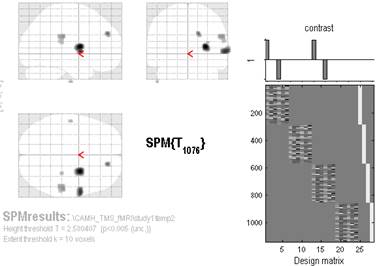 |
As a follow up, based on some past experiences I have always been concerned that having different durations for different event types may result in false positives. For example, if type 1 had a duration of 0.5 seconds and was contrasted with type 2, which had a duration of 3 seconds. As you are explicitly modelling that the HRF for type 2 should be larger than that for type 2, I think you may find false positives in regions where they had similar amplitudes of responses.
I gave this a little test on a single subject. In the original analysis I used an event duration of 0 which was appropriate to the design. I have previously run split-half reliability analysis on this data set so I know the response between trials is highly stable.
I think this shows a good examples of the dangers of modelling different event durations across different trial types. IMHO this include using RT as event duration when RT is not matched between trials. None of this applies when event-specific durations are modelled but are similar across trial types.
I ran a test splitting the trials in half (there was a single event type). Here is the results, p<0.005 k = 10, when I just split the trials in half (note this is a great example of what is almost certainly a false positive using a low threshold):

If I make the first half duration = 0.5 (very similar to dur = 0 except for amplitude) and the other half duration = 3, we get a lot more false positives.

Colin Hawco, PhD
Neuranalysis Consulting
Neuroimaging analysis and consultation
From: SPM (Statistical Parametric Mapping) [mailto:[log in to unmask]] On Behalf Of MCLAREN, Donald
Sent: December-01-16 1:12 PM
To: [log in to unmask]
Subject: Re: [SPM] Calculating a GLM: Specify event durations or leave at 0?
Yes. You are right. Assuming that conditions are constant in neural activity duration, modeling under 2s doesn't make much of a difference. However, as soon as you have variable condition durations, I believe you need to account for the differential durations. My point was more that, once you pass 2s, you need to model the duration even for constant duration events.
With regard to (4), I just checked the most recent SPM release (r6906) and 0s is different from 0.0001s is different from 0.1s duration events, so there still seems to be some differences.
Best Regards,
Donald McLaren, PhD
On Thu, Dec 1, 2016 at 12:04 PM, MRI More <[log in to unmask]> wrote:
Dear Donald,
(1) only holds if you remain within conditions though. If mean RT is 300 ms in one condition and 500 ms in another you will obtain different results for the differential contrast depending on whether you go with a fixed duration across conditions (be it 0 or 2 s or 400 ms) or the condition means.
With regard to (4), I could be wrong but I think this was adjusted in one of the SPM12 updates this or last year.
Best regards
Helmut